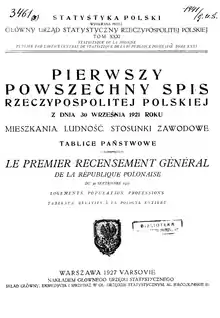Polish census of 1921
The Polish census of 1921 or First General Census in Poland (Polish: Pierwszy Powszechny Spis Ludności) was the first census in the Second Polish Republic, performed on September 30, 1921 by the Main Bureau of Statistics (Główny Urząd Statystyczny). It was followed by the Polish census of 1931.
| Polish census of 1921 | |
|---|---|
| 1921 Census of Poland, vol. 31: Population by Religion and Nationality (go to p. 80: PDF) | |
 |
Content
Due to war, not all of interwar Poland was enumerated. Upper Silesia was formally assigned to Poland by the League of Nations after the census was conducted elsewhere. Meanwhile, the conditions in eastern Galicia were still unstable and chaotic, and the census data had to be adjusted after the fact, wrote Joseph Marcus, thus leading to more questions than answers.[1] The army and personnel under military jurisdiction were not included in the results. Also, specific areas of considerable size lacked complete returns due to absence of war refugees.[2]
Entire categories considered essential today were absent from the questionnaires, subject to historic interpretation at any given time. For example, the Ukrainians were lumped with the Rusyns (as Ruthenes) with the only distinguishing factor possible being religion. Within a single total number of Ruthenes (narodowość rusińska), separate categories existed only for Greek Catholics (68.4 percent or 2,667,840 of them) and Orthodox Christians (31 percent or 1,207,739 of the total),[page 80] but did not address language in the same way as the next Polish census of 1931. Neither the Ukrainians, Carpatho-Rusyns (or Rusnaks), nor Polesians were defined by their name. The categories listed in the census included verbatim: Narodowość: polska (polonais), rusińska (ruthènes), żydowska (juifs), białoruska (biėlorusses), niemiecka (allemands), litewska (lithuaniens), rosyjska (russes), tutejsza (indigène), czeska (tchèques), inna (autre), niewiadoma (inconnue).[3]
Results
| All | Polish | Ruthenians[4] | Jewish | Belarusian | German | Lithuanian[5] | Russian | "local" | Czech | other | unknown |
|---|---|---|---|---|---|---|---|---|---|---|---|
| 25.694.700 | 17.789.287 | 3.898.428 | 2.048.878 | 1.035.693 | 769.392 | 24.044 | 48.920 | 38.943 | 30.628 | 9.856 | 631 |
| 100% | 69,23% | 15,17% | 7,97% | 4,03% | 2,99% | 0,09% | 0,19% | 0,15% | 0,12% | 0,04% | ~0,002% |
References
- Joseph Marcus (1983). Social and Political History of the Jews in Poland, 1919-1939. Walter de Gruyter. p. 17. ISBN 9027932395.
- Library of Congress. Census Library Project, Henry Joachim Dubester, United States. Bureau of the Census (1948). Poland. Census of 1921. National censuses and vital statistics in Europe, 1918-1939: an annotated bibliography. U.S. Govt. Print. Off. p. 145 – via Google Books.CS1 maint: uses authors parameter (link)
- Central Statistical Office of the Polish Republic (1927). Population of Poland according to religious denominations and nationality [Ludność według wyznania religijnego i narodowości] (PDF). First National Census of 30 September 1921. Warszawa: GUS. page 80/109 in PDF, page 56 in census results: Table XI. Retrieved 14 October 2015.
- The exonym Ruthenians (the Ruthenes in the 1921 census) have been applied to East Slavic nationalities including Ukrainians and Rusyns or ethnic groups related to them: see Rusyn, Ruthenian, Carpatho-Rusyn, Lemko or Rusnak in Britannica.
- Data do not include: city Vilnius, county Vilnius-Trakai, Ashmyany, Švenčionys, Vilnius Region and Upper Silesia